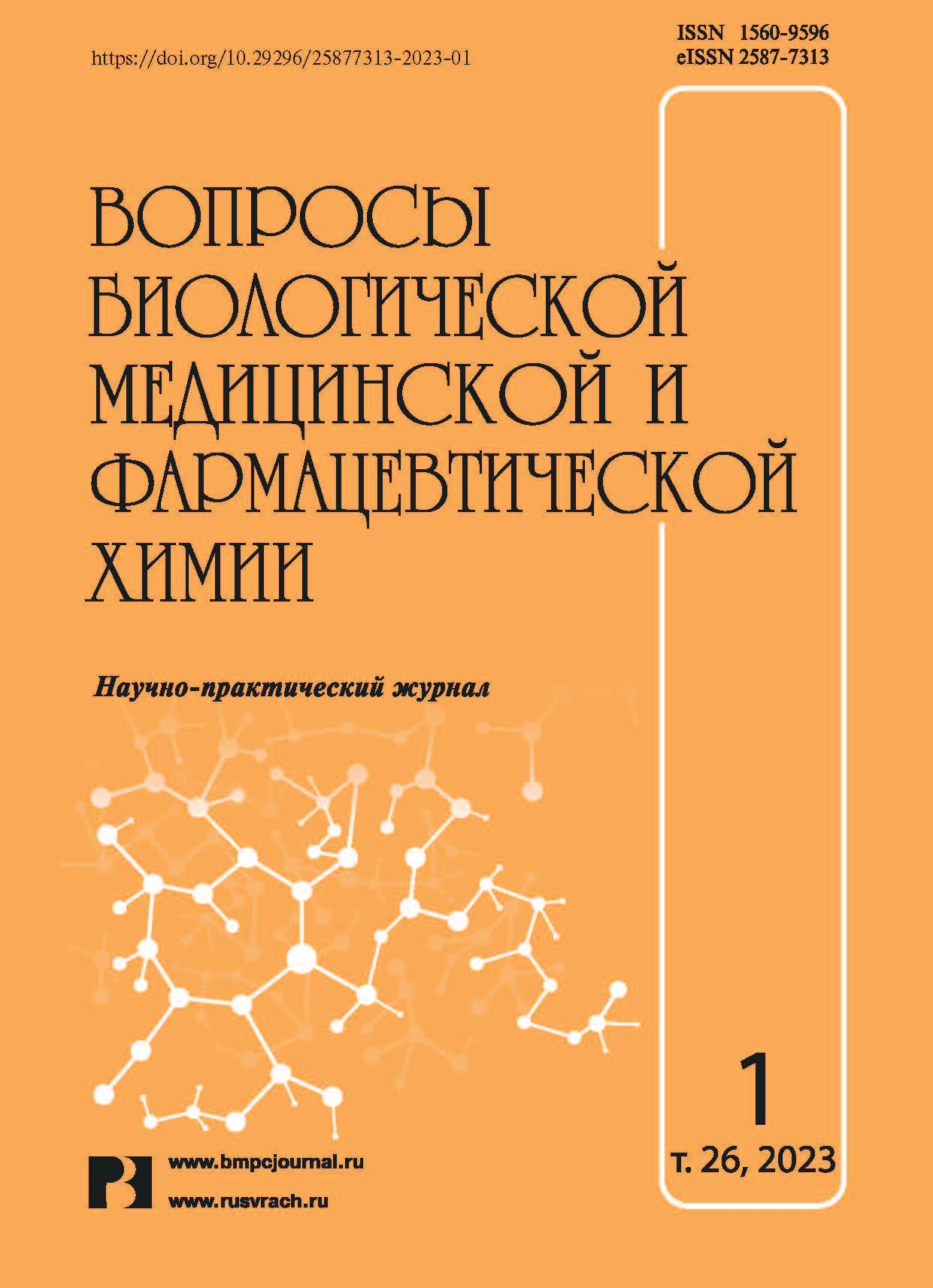Воздействие 6-гидрокси-2,2,4-триметил-1,2-дигидрохинолина на показатели оксидативного статуса и активность ферментов метаболизма дикарбоновых кислот при токсическом поражении печени у крыс
- Авторы: Синицына Д.А.1, Попова Т.Н.1, Крыльский Е.Д.1, Шихалиев Х.С.1, Лебедева Ю.И.1, Жеребцова Е.В.1, Попова Д.А.1
-
Учреждения:
- Воронежский государственный университет
- Выпуск: Том 26, № 1 (2023)
- Страницы: 43-48
- Раздел: Вопросы экспериментальной биологии и медицины
- URL: https://journals.eco-vector.com/1560-9596/article/view/535046
- DOI: https://doi.org/10.29296/25877313-2023-01-08
- ID: 535046
Цитировать
Полный текст
Аннотация
Одной из распространённых проблем здравоохранения в настоящее время являются токсические поражения печени. Ключевым механизмом патогенного действия ксенобиотиков на печень выступает активация окислительного стресса. Чрезмерно генерируемые свободные радикалы повреждают компоненты митохондрий в гепатоцитах, что может приводить к нарушению функционирования митохондриальных дегидрогеназ.
Цель работы – изучение воздействия антиоксиданта 6-гидрокси-2,2,4-триметил-1,2-дигидрохинолина на параметры оксидативного статуса, активность сукцинатдегидрогеназы и НАД-зависимой малатдегидрогеназы при токсическом поражении печени у крыс.
Материал и методы. В исследовании использовали 48 самцов белых крыс Wistar массой 200–250 г, разделенных на 4 группы по 12 особей в каждой: контрольную группу, группу животных с тетрахлорметан-индуцированным поражением печени, крыс с патологией, получавших внутрижелудочно 6-гидрокси-2,2,4-триметил-1,2-дигидрохинолин в дозе 50 мг/кг, и контрольных крыс, которым давали тестируемое соединение. В печени и сыворотке крови оценивали уровень окислительной модификации белков методом Reznick et al. с небольшими модификациями, концентрации альфа-токоферола методом, основанным на измерении поглощения хромогенного комплексного соединения Fe2+ и ортофенантролина. Активность аланинаминотрансферазы, аспартатаминотрансферазы и гамма-глутамилтранспептидазы определяли в сыворотке крови с использованием наборов реагентов («Ольвекс Диагностикум», Санкт-Петербург). Для анализа активности сукцинатдегидрогеназы и НАД-зависимой малатдегидрогеназы получены цитоплазматическая и митохондриальная фракции печени.
Результаты. Введение 6-гидрокси-2,2,4-триметил-1,2-дигидрохинолина способствовало нормализации анализируемых параметров, что, по-видимому, происходило вследствие коррекции редокс-статуса в печени животных под действием тестируемого соединения.
Выводы. Результаты исследования обусловливают необходимость дальнейшего изучения влияния дигидрохинолиновых производных на ферменты окислительного метаболизма при патологических состояниях, сопряженных с оксидативным стрессом.
Полный текст
Об авторах
Д. А. Синицына
Воронежский государственный университет
Автор, ответственный за переписку.
Email: evgenij.krylsky@yandex.ru
аспирант, кафедра медицинской биохимии и микробиологии
Россия, г. ВоронежТ. Н. Попова
Воронежский государственный университет
Email: evgenij.krylsky@yandex.ru
д.б.н., профессор, декан медико-биологического факультета
Россия, г. ВоронежЕ. Д. Крыльский
Воронежский государственный университет
Email: evgenij.krylsky@yandex.ru
к.б.н., доцент, кафедра медицинской биохимии и микробиологии
Россия, г. ВоронежХ. С. Шихалиев
Воронежский государственный университет
Email: evgenij.krylsky@yandex.ru
д.х.н., профессор, зав. кафедрой органической химии
Россия, г. ВоронежЮ. И. Лебедева
Воронежский государственный университет
Email: evgenij.krylsky@yandex.ru
студентка, кафедра медицинской биохимии и микробиологии
Россия, г. ВоронежЕ. В. Жеребцова
Воронежский государственный университет
Email: evgenij.krylsky@yandex.ru
студентка, кафедра медицинской биохимии и микробиологии
Россия, г. ВоронежД. А. Попова
Воронежский государственный университет
Email: evgenij.krylsky@yandex.ru
студентка, кафедра медицинской биохимии и микробиологии
Россия, г. ВоронежСписок литературы
- Liu Y., Wen P.H., Zhang X.X., et al. Breviscapine ameliorates CCl4 induced liver injury in mice through inhibiting inflammatory apoptotic response and ROS generation. Int. J. Mol. Med. 2018; 42: 755–768.
- Forrester S. J., Kikuchi D. S., Hernandes M. S. et al. Reactive oxygen species in metabolic and inflammatory signaling. Circ Res. 2018; 122: 877–902.
- Rutter J., Winge D.R., Schiffman J.D. Succinate dehydrogenase – Assembly, regulation and role in human disease. Mitochondrion. 2010; 10: 393–401.
- Musrati R. A., Kollárová M., Mernik N., et al. Malate Dehydrogenase: Distribution, Function and Properties. Gen Physiol Biophys. 1998; 17: 193–210.
- Iskusnykh I. Y., Krylskii E. D., Brazhnikova D. A. et al. Novel Antioxidant, Deethylated Ethoxyquin, Protects against Carbon Tetrachloride Induced Hepatotoxicity in Rats by Inhibiting NLRP3 Inflammasome Activation and Apoptosis. Antioxidants. 2021; 10: 122.
- Reznick A.Z., Packer L. Oxidative damage to proteins: spectrophotometric method for carbonyl assay. Methods Enzemol. 1994; 233: 357–363.
- Desai I.D., Martinez F.E. Bilirubin interference in the colorimetric assay of plasma vitamin E. Clin. Chim. Acta. 1986; 154: 247–250.
- Bailey C.A., Srinivasan L.J., McGeachin R.B. The effect of ethoxyquin on tissue peroxidation and immune status of single comb White Leg-horn cockerels. Poult Sci. 1996; 75: 9–12.
- Pougeois R., Satre M., Vignais P.V. N-ethoxycarbonyl-2-ethoxy-1,2-dihydroquinoline, a new inhibitor of the mitochondrial F1-ATPase. Biochemistry. 1978; 17: 3018–3023.
- Steverding D., Kadenbach B. Influence of N-ethoxycarbonyl-2-ethoxy-1,2-dihydroquinoline modification on proton translocation and membrane potential of reconstituted cytochrome-c oxidase support “proton slippage”. Journal of Biological Chemistry. 1991; 266: 8097–8101.
Дополнительные файлы










